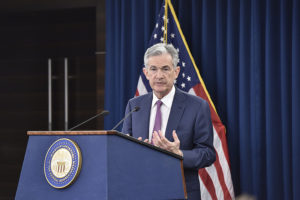The Fed has simply been talking its book, making bold statements about its intentions to raise rates, but guess what? Talk is cheap.
Actually, this kind of talk is quite expensive. Investors are worried the Fed might not be capable of—putting it kindly—cleaning up the mess in aisle two.
They need to be aggressive with the rate increases and they need to do it now.
Nick Timraos reports for The Wall Street Journal:
Federal Reserve officials have spent the past two months getting investors acclimatized to their plans to slow economic growth and combat inflation by raising interest rates in half-percentage-point increments until price pressures cool.
This coming week’s policy meeting will show whether officials are still comfortable with that approach in light of reports Friday that inflation sizzled in May, hitting a new 40-year high, and that consumers’ longer-term inflation expectations rose to a new 14-year high. The survey measure is important to central bankers because they believe such expectations can be self-fulfilling.
While some analysts think Fed Chairman Jerome Powell could surprise markets with a larger than anticipated rate increase of 0.75 percentage point, such a move remains unlikely because it would be a notable departure from how the central bank has conducted policy this year.
That is especially the case when officials have other devices at their disposal to signal a more aggressive posture, including in new rate and economic projections to be released Wednesday. Mr. Powell will elaborate on the rate outlook at his press conference later that day.
The bigger questions Wednesday center on how high officials see rates rising this year and next, and whether Mr. Powell opens the door to a 0.75 percentage point rate increase at the central bank’s July policy meeting.
Fed officials said in recent weeks they were likely to follow an anticipated half-point rate rise this coming week with another one in July. But that was before Friday’s reports, which were worse than what officials had expected.
The problems caused by Fed inaction are not abstract. Cost increases on farms and in factories are directly affecting the American people, and their standard of living. The Wall Street Journal reports elsewhere:
From farmers and factories to grocery stores and restaurants, many executives say they are experiencing jaw-dropping cost increases for labor, packaging, ingredients and transportation. The rise of fuel prices is making it more expensive to produce and sell food. Food retailers and restaurants have said they are passing along some wholesale price increases and additional costs to consumers.
The Labor Department on Friday said grocery prices rose 11.9% in May over the past year, and prices increased 7.4% at restaurants and other food venues outside the home in the period. For both, it marks the biggest jump in over four decades.
Action Line: If you need help building an investment plan for a rising interest rate environment, I can help. If you want to get to know me better before we connect, click here to subscribe to my free monthly Survive & Thrive letter, and let’s weather this storm together.
Originally posted on Your Survival Guy.

